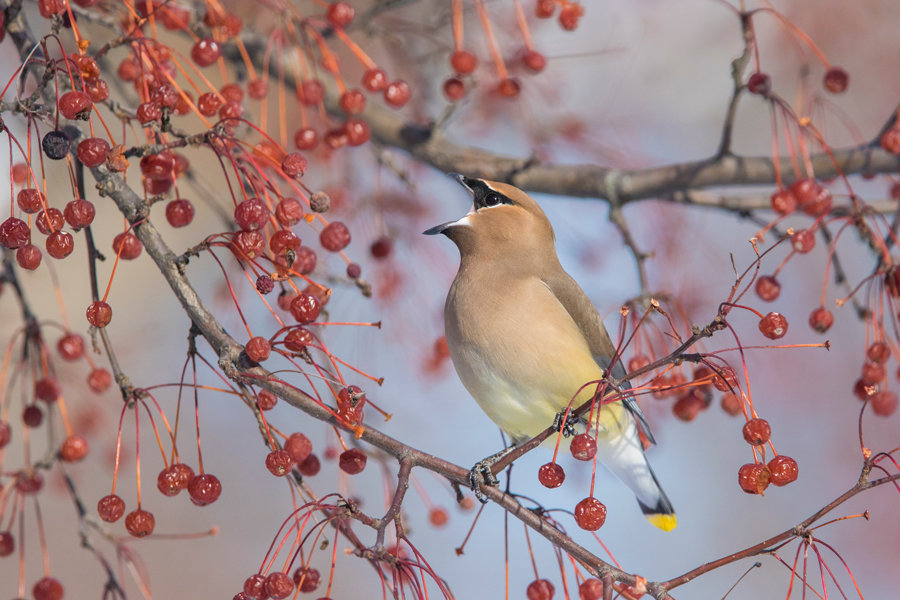
Fall again. Heavy sunflower heads have fallen and the clouds of goldfinches that came for their seeds have scattered into the trees. Rain falls and rotting resumes. Down come the soggy stems of garden plants; up come the pulpy stalks of mushrooms. And yet in the forest, branches are still loaded with berries.
It’s a movable feast, the yearly cycle of wild berries. Salmonberries, elderberries, twin berries, trailing blackberries, blackcap raspberries, cascara berries, salal berries — to name just a few — roll through the countryside, high and low, some patches abundant this year when they struggled last.
And the berry hunters follow them. I’m on a quiet road when I hear the shaking of leaves overhead. I look up expecting a squirrel and instead see two band-tailed pigeons. They are broad-chested. Light catches their metallic green necks as they stretch to take madrona berries. They move sedately. Suddenly, above them, a dozen cedar waxwings hurtle past. Three split off and wheel down to join the pigeons. They snatch a few berries before launching into the air again.
To see the two species together in a fruiting madrona, even for a moment, makes my walk. Both love berries. Both are known for being unpredictable travelers. Band-tailed pigeons migrate by hopping from food source to food source, wherever the food happens to be, making their journeys look like paisley patterns. Sometimes they congregate in huge numbers. Even in the breeding season they like to be in small bands: Berries are not a food that must be jealously guarded.
Waxwing flocks are well known for appearing and disappearing like pirates. They arrive at the peak of berry freshness — or beyond, as they are sometimes found drunk on partially fermented fruits, each one a little flying Bacchus. Waxwings will tweak the timing of their egg-laying, often delaying it into late summer to take advantage of the richest harvests.
Berries, it occurs to me, exist to stir things up. They get us all poking around off trail, bringing circulation to the forgotten corners of our landscapes.
I’m thinking of how Indigenous people in this area had camps dedicated to picking and preserving berries. And the early pioneers competed to see which homestead could invent the most effective berry-cleaning machine. After beating the bushes for miles around, they would dump bucket loads of leaves, spiders, twigs and berries into contraptions that huffed and spun and shook and hopefully removed most of the chaff. It was an event every bit as social as an apple cider squeeze.
An old-timer once told me a story. As a middle schooler in the 1930s, he had a thing for a girl who lived a few miles away. He was horrified when she told him she had never tried a blueberry pie. He recruited his mother as baker and the next day carried a pie to his beloved. I imagine him balancing it for miles through the forest, its crust barely holding in a mass of sweet and sticky berries — a currency of love as potent as gemstones.
The wild outdoors can feel like a place of barks and crusts. When the berries come bursting forth it feels like an undeserved gift. They stir our bodies and blood.
And berries are abundant, one of the plant kingdom’s most repeated feats, independently developed in a number of plant lineages. It may seem counterintuitive for a plant to surround its seeds with food — like clothing our own babies in bear chow — yet it has proved remarkably effective at solving an age-old plant problem: how a non-moving being can move its seeds to new and distant sites.
Berries first came on the scene in the Cretaceous Period, toward the end of the age of dinosaurs. It was a time when flowering plants in general were diversifying into the multitude of families we know today. The resultant tangled forests had little wind to carry airborne seeds and low light where seeds might germinate. At the same time, birds and mammals were proliferating, populating Earth with highly mobile creatures with broad diets. Some flowering plants took advantage, offering them fruit, and the selective palates of birds, primates and bats sped the evolution of tastier berries.
Not only were they tastier, they became chemically sophisticated. Most fruits are richer in phytochemicals than the leaves that herbalists and scientists have focused upon. A study of a Costa Rican cloud forest shrub with berries and the bird that ate them found that the berries contain a custom laxative. The more time a berry’s seeds spend in a bird’s gut, the farther they travel. But the less time the seeds spend in a gut, the more likely they are to grow. The berries effectively balance the trade-off by holding just the right dose of the laxative.
So, berries keep things moving. They appear in tangled corners and ask to be carried here and there, shared. I admit I cannot understand the landowners who wipe clean their forest floors. One of our neighbors takes a blower to the soil until it is bare of the tiniest fallen twig. Maybe it looks kempt. I don’t know. So exposed, soil cannot hold water against drought, much less transform it into the berry harvest we all love. Shouldn’t we encourage the tangle that gives birth to free food?
I push into the woods with the waxwings, my other neighbors, eating a huckleberry here and there and thinking how good it feels to poke around. We are born movers, and the berries that stir us appreciate our passage.
UNDERWRITTEN BY THE FUND FOR NONPROFIT NEWS (NEWSMATCH) AT THE MIAMI FOUNDATION, THE ANGEL GUILD, ADVERTISERS, DONORS AND PEOPLE WHO SUPPORT INDEPENDENT, NONPROFIT LOCAL NEWS